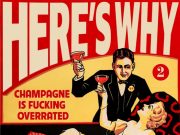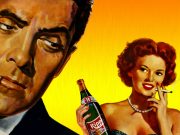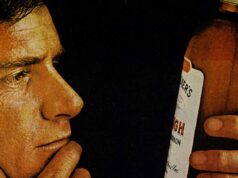Somebody…
Somebody…
Somebody put somethin’
In my drink.
—The Ramones
Over the course of humankind’s long, lovely relationship with liquor, various persons have, at various times and for various, largely despicable reasons, felt it necessary to “doctor” another fellow’s beverage for the purpose of rendering him insensate and stealing his shiny stuff.
This obnoxious practice went without a commonly employed name for quite a long time—until 1904 (or, according to some sources, as late as 1918), when unscrupulous barkeeps in Chicago’s grimy Whiskey Row district adopted the title “Mickey Finn,” and the concept of “slipping” someone “a mickey” was born. And why “Mickey Finn?” Because Mickey Finn was the name of the man who, while he did not invent the reprehensible custom, was responsible for transforming it into a sort of vile art.
At five feet four inches tall and barely a 140 pounds, Mickey Finn was a tiny goblin of a man, with a soul blacker and colder than Dante’s pits. He arrived in Chicago, from (so far as anyone knows) Peoria (or maybe Ireland), during the World’s Fair of 1893, and promptly set about seeking his fortune by rolling intoxicated pedestrians in the Little Cheyenne district. He tended bar for a time at a joint called Toronto Jim’s, but was fired after an altercation with a customer, during which he yanked the unfortunate man’s eye from its socket. For the next couple of years he worked as a pickpocket and as a fence for a gang of half-assed burglars before opening his own establishment, the Lone Star Saloon and Palm Garden, on Whiskey Row in 1896.
A combination saloon/eatery/whorehouse, the place was dingy, dimly lit and smoky. The Palm Garden was a single stunted palm plant in the corner of one room, wilting in an old spittoon. A police inspector named Lavin called the Lone Star “a low dive, a hang-out for…people of the lowest type,” and the historian Herbert Asbury wrote that the joint’s usual customers were “human lice.” Despite such negative reviews (or, more likely, because of them), the Lone Star thrived under Finn’s management.
Finn used the premises as a front for his continuing fence work, and operated a school for pre-teen pickpockets and streetwalkers with an itch to enhance their revenue streams. Criminal gangs used the Lone Star for meetings. Crooked cops came and went (by appointment) to receive their envelopes of cash. The girls who worked the saloon had one job: encourage their johns to keep buying rounds of drinks. If all went well, the guy would get so drunk he couldn’t do what he’d gone there to do, and the girl could move right on to another victim without wasting time changing her sheets.
Finn owed more than a little of his success to his wife and right-hand, Kate Roses, a some-time whore and full-time thief and grifter. Kate managed the prostitution end of the Lone Star’s business. She recruited new girls and disposed of those who, due to disease or a lack of effort, no longer earned their keep. She usually accomplished this by beating them unconscious and dumping them in an alley, or by selling them for pennies-on-the-pound to even lower-class houses. Her temper rivaled her husband’s, and sensible people took care to stay on Kate’s sunny side.
The Lone Star’s liquor business was overseen by a hulking fellow known only as Patsy. He purchased the booze, supervised its watering-down and served as the saloon’s main bartender. From his position behind the bar he was able to identify potential victims for Finn or the girls, which made him a valuable part of the enterprise. When a girl had zeroed in on her prey, Patsy increased the power of the guy’s drinks while decreasing the girl’s, so that she stayed sober while the victim continued sliding toward a black-out, from which he would likely awaken in some cold alley, divested of his money, jewelry and, as often as not, clothing. When it came to thievery of this sort, two of the Lone Star’s best girls were Isabelle Ffyffe—called “Dummy” because she was one—and “Gold Tooth” Mary Thornton, so-named because her single remaining tooth was capped in the stuff (and, gosh, what a looker she must’ve been).
For the first few years Mickey Finn operated the Lone Star, he made pretty good money selling weak drinks and by taking a hefty cut of the bawdy-girls’ earnings, but he wasn’t bringing in the amount of green he wanted or felt was his due. All that changed, however, in the summer of 1898, when Finn made the acquaintance of a black voodoo priest, known to history only as Doctor Hall, who sold magical love potions and snake-oil cures for venereal disease, as well as vials of morphine and bindles of cocaine to house-girls. After a meeting with Hall, Finn returned to the Lone Star bubbling with excitement, cradling a large brown pharmacist’s bottle in his arms. He held the bottle, which was full of white powder, up for “Gold Tooth” Mary’s inspection, and said, “See the nice bottle, Mary? We’ll get the money with this. I give the Doc an extra dollar to make it strong.” No one knows for sure, but the powder may have been chloral hydrate.
Within the week, two new drinks debuted at the Lone Star, both of Mickey Finn’s invention. The first was the Mickey Finn Special, a concoction of raw alcohol, water, snuff and a brutal measure of the white powder. The second was the Number Two, which was essentially the same as the Special, except with beer in the place of the raw alcohol. When a victim drank one of Mickey’s druggy cocktails, he walked around in a restless stupor for a few minutes before collapsing into a deep sleep. He usually remained in this coma-like state until the drug ran its course, which often took 12 hours or more, and when he did finally come to, his befuddlement could linger for hours, even days. Finn’s beady little eyes gleamed with greed and malice every time he heard a potential victim call confidently for a Special or a Number Two.
Mickey Finn and his accomplices were quite a team. Once a dupe had been identified, and Patsy and the girls had done their bit, Finn and Kate Roses would drag the unlucky bastard off to “the operating room.” There they would strap the man to a table, strip him naked, and painstakingly search every inch of his clothing and person—for money, watches, jewelry and anything else that looked valuable. They liked fancy clothing as well, especially shoes and hats, which could be sold on the black market. Gold teeth were fair game— Finn kept a pair of pliers for extraction purposes. He also kept a wooden mallet at hand, just in case the victim showed signs of returning to consciousness—two or three whacks usually did the trick.
The operation went gangbusters until the spring of 1903 when “Gold Tooth” Mary Thornton, afraid she was about to be murdered for knowing too much, quit the Lone Star under cover of night and, having persuaded Dummy Ffyffe to join her, went to the police and ratted out the whole show. The women were taken before the Chicago Vice Commission, where they repeated their charges, but since the Commission lacked the testimony of an actual victim, its members were hesitant to act against Mickey Finn. They did eventually have him arrested for robbing customers after drugging their drinks but was released for a lack of evidence. The Commission then made the only move they had left and revoked the Lone Star’s liquor license in December of 1903.
Feeling the heat, Finn skulked out of Chicago to parts unknown. He returned in late 1904, inexplicably broke and in need of work. It is known that he tended bar at a saloon on Dearborn Street, but no further details are available. Over the next few years, other ethically-challenged barkeeps began serving “knock-out specials” with several claiming that they had purchased the formula from Finn. These statements are the last mentions of Mickey Finn in the historical record.
Keep in mind that everything I just wrote about Mickey Finn of Chicago should be taken with a grain of salt. The jury is still out as to where “mickey finn” originated. The historian Herbert Asbury, from whose books much of the above information was gleaned, was a fine researcher, with access to numerous documents, the most notable of which were court papers in which contained the testimony of Isabelle “Dummy” Ffyffe and “Gold Tooth” Mary Thornton. Both women provided detailed descriptions of Finn’s ugly activities. Asbury’s portrayal of events is compelling and, to me, convincing, and I’m willing to let it stand until better information comes to light.
When you get right down to it, it makes little difference where the phrase “Mickey Finn” came from. What’s important is that doctoring someone’s drink, no matter the intended result, is a revolting practice and people caught engaging in it should be expelled from drinking society, and forced to serve as a cabana-boy for one of MADD’s more withered executives.










